Design and Experimental Evaluation of Composite Magnesium Phosphate Cement-Based Coating with High Cooling Effect
Abstract
:1. Introduction
2. Experimental Procedures
2.1. Raw Materials
2.2. Research Route
2.3. Preparation of MPC Coating
2.4. Performance Characterization Methods
2.4.1. Fluidity and Setting Time Test
2.4.2. Compressive and Flexural Test
2.4.3. Adhesive Strength Test
2.4.4. Thermal Property Test
2.4.5. Micro Characterizations
2.4.6. Laboratory Irradiation Test
3. Results and Discussion
3.1. Basic Ratio Determination of MPC
3.1.1. M/P Ratio Optimization
3.1.2. Initial Adjustment of the Water-Solid Ratio
3.2. Effect of Titanium Dioxide Content on the Performance of MPC-T Pastes
3.2.1. Cooling Performance
3.2.2. Thermal Conductivity
3.2.3. Spectral Reflectance
3.3. Effect of Glass Bead Content on the Performance of MPC-TG Pastes
3.3.1. Re-Adjustment of Water-Solid Ratio
3.3.2. Cooling Performance
3.3.3. Thermal Conductivity
3.3.4. Spectral Reflectance
3.4. Performance Evaluation of Optimized MPC-Based Pastes
3.4.1. Physical Performance Evaluation
3.4.2. Phase Composition Analysis
3.4.3. Internal Morphology Analysis
3.4.4. Thermal Stability Analysis
4. Conclusions
- (1)
- Magnesium ammonium phosphate cement itself has certain reflective cooling properties, and the addition of titanium dioxide can further improve the cooling properties of MPC coating. Through the results of the 100 min irradiation test, it was determined that the amount of titanium dioxide admixture was 2% of the mass of magnesium oxide. At this point, in comparison to the uncoated concrete block, the surface temperature was reduced by 13.6 °C, a reduction of 26%, and the internal temperature was reduced by 11.5 °C, also a reduction of 26%. By continuing to increase the amount of titanium dioxide at this point, the improvement in temperature reduction was no longer significant.
- (2)
- The reflective cooling effect of the coating was further enhanced by adding glass beads on top of the 2% titanium dioxide. The glass beads achieved an increased cooling effect by reducing the thermal conductivity of the MPC-based pastes. When the amount of glass bead admixture reached 8% of the mass of magnesium oxide, the surface temperature continued to reduce by 3.9 °C, and the internal temperature continued to reduce by 2.2 °C after 100 min of irradiation. At this point, continuing to add glass beads will make the prepared coating less liquid and reduce construction operability. Therefore, the dosage of glass beads is 8% of the mass of magnesium oxide.
- (3)
- Based on SEM, XRD, and TG/DTG results, the MPCTG cooling coating hydrates well, with a large amount of hydration products encasing unreacted MgO particles, titanium dioxide, and glass bead, forming a dense monolith with high reflection and low thermal conductivity, effectively blocking the entry of radiant heat. At the same time, the MPCTG coating prepared is stable below 70 °C, while the summer high-temperature disease of the concrete structure usually does not exceed 70 °C.
Author Contributions
Funding
Institutional Review Board Statement
Informed Consent Statement
Data Availability Statement
Acknowledgments
Conflicts of Interest
References
- Farhan, S.; Ismail, F.; Kiwan, O.; Shafiq, N.; Zain-Ahmed, A.; Husna, N.; Hamid, A. Effect of Roof Tile Colour on Heat Conduction Transfer, Roof-Top Surface Temperature and Cooling Load in Modern Residential Buildings under the Tropical Climate of Malaysia. Sustainability 2021, 13, 4665. [Google Scholar] [CrossRef]
- Xue, X.; Yang, Z.; Li, Y.; Sun, P.; Feng, Y.; He, Z.; Qu, T.; Dai, J.-G.; Zhang, T.; Qin, J.; et al. Superhydrophobic self-cleaning solar reflective orange-gray paint coating. Sol. Energy Mater. Sol. Cells 2018, 174, 292–299. [Google Scholar] [CrossRef]
- Rizwan, A.M.; Dennis, L.Y.; Chunho, L. A review on the generation, determination and mitigation of Urban Heat Island. J. Environ. Sci. 2008, 20, 120–128. [Google Scholar] [CrossRef]
- Chen, Z.; Xiao, J.; Liu, X.; Qin, H.; Yang, R. Deformation behavior of slab warping for longitudinal continuous rigid slab under temperature effect. Adv. Struct. Eng. 2019, 22, 2823–2836. [Google Scholar] [CrossRef]
- Zeng, X.; Zhu, H.; Qiu, X.; Yang, K.; Wang, P.; Xie, Y.; Long, G. Deterioration of CA mortar filling layer under cyclical thermal loading. Constr. Build. Mater. 2020, 259, 119678. [Google Scholar] [CrossRef]
- Li, Y.; Chen, J.J.; Wang, J.X.; Shi, X.F.; Chen, L. Study on the interface damage of CRTS II slab Applied Chemistry for Engineeringtrack under temperature load. Structures 2020, 26, 224–236. [Google Scholar] [CrossRef]
- Song, L.; Liu, H.; Cui, C.; Yu, Z.; Li, Z. Thermal deformation and interfacial separation of a CRTS II slab ballastless track multilayer structure used in high-speed railways based on meteorological data. Constr. Build. Mater. 2020, 237, 117528. [Google Scholar] [CrossRef]
- Synnefa, A.; Santamouris, M.; Livada, I. A study of the thermal performance of reflective coatings for the urban environment. Sol. Energy 2006, 80, 968–981. [Google Scholar] [CrossRef]
- Zhang, Y.; Long, E.; Li, Y.; Li, P. Solar radiation reflective coating material on building envelopes: Heat transfer analysis and cooling energy saving. Energy Explor. Exploit. 2017, 35, 748–766. [Google Scholar] [CrossRef]
- Li, Y.; Chen, J.; Jiang, Z.; Cheng, G.; Wang, J.; Shi, X. Thermal performance of the solar reflective fluorocarbon coating and its effects on the mechanical behavior of the ballastless track. Constr. Build. Mater. 2021, 291, 123260. [Google Scholar] [CrossRef]
- Miao, C.; Li, Z.; Li, K.; Lv, Y.; Wu, X.; Cao, X.; Wu, Y. A super-cooling solar reflective coating with waterborne polyurethane for asphalt pavement. Prog. Org. Coat. 2022, 165, 106741. [Google Scholar] [CrossRef]
- Pan, B.C.; Ren, P.H.; Zhou, T.J.; Cai, Z.Y.; Zhao, X.J.; Zhou, H.M.; Xiao, L.R. Microstructure and Property of Thermal Insulation Coating on the Carbon Fiber Reinforced Epoxy Resin Composites. J. Inorg. Mater. 2020, 35, 947–952. [Google Scholar] [CrossRef]
- Zhou, A.; Yu, Z.; Chow, C.L.; Lau, D. Enhanced solar spectral reflectance of thermal coatings through inorganic additives. Energy Build. 2017, 138, 641–647. [Google Scholar] [CrossRef]
- Perera, D.Y. Physical ageing of organic coatings. Prog. Org. Coat. 2003, 47, 61–76. [Google Scholar] [CrossRef]
- Zhang, Z.; Wu, J.; Zhao, X.; Zhang, Y.; Wu, Y.; Su, T.; Deng, H. Life evaluation of organic coatings on hydraulic metal structures. Prog. Org. Coat. 2020, 148, 105848. [Google Scholar] [CrossRef]
- Spee, T.; Van Duivenbooden, C.; Terwoert, J. Epoxy Resins in the Construction Industry. Ann. N. Y. Acad. Sci. 2006, 1076, 429–438. [Google Scholar] [CrossRef]
- Hwang, S.I.; Kim, Y.J.; Kim, D.K. A study on the synthesis of acrylic phenol resins and their properties as a paint. Appl. Chem. Eng. 2013, 24, 171–176. [Google Scholar]
- Anshul, A.; Moinuddin, A.A.; Azad, A.M.; Khera, P.; Dehariya, K.; Bherwani, H.; Gupta, A.; Kumar, S. Morphologically designed micro porous zeolite-geopolymers as cool coating materials. J. Hazard. Mater. 2020, 398, 123022. [Google Scholar] [CrossRef]
- Zhang, Z.; Wang, K.; Mo, B.; Li, X.; Cui, X. Preparation and characterization of a reflective and heat insulative coating based on geopolymers. Energy Build. 2015, 87, 220–225. [Google Scholar] [CrossRef]
- Wang, F.; Xie, T.; Ou, J.; Xue, M.; Li, W. Cement based superhydrophobic coating with excellent robustness and solar reflective ability. J. Alloys Compd. 2020, 823, 153702. [Google Scholar] [CrossRef]
- Li, M.; Hong, Y.; Yu, H.; Qu, S.; Wang, P. A novel high solar reflective coating based on potassium silicate for track slab in high-speed railway. Constr. Build. Mater. 2019, 225, 900–908. [Google Scholar] [CrossRef]
- Ma, Y.; Nie, X.; Northwood, D.; Hu, H. Corrosion and erosion properties of silicate and phosphate coatings on magnesium. Thin Solid Films 2004, 469–470, 472–477. [Google Scholar] [CrossRef]
- Rong, X.; Wang, Z.; Xing, X.; Zhao, L. Review on the Adhesion of Geopolymer Coatings. ACS Omega 2021, 6, 5108–5112. [Google Scholar] [CrossRef] [PubMed]
- Zhang, J.; Jiang, H.; Ding, F.; Zhang, P.; Zhou, F.; Li, T.; Duan, N. Effects of metal–ceramic anticorrosion coating on the performance of ballastless tracks at high temperature. Arch. Civ. Mech. Eng. 2020, 20, 1–14. [Google Scholar] [CrossRef]
- Thejus, P.; Krishnapriya, K.; Nishanth, K. NIR reflective, anticorrosive magenta pigment for energy saving sustainable building coatings. Sol. Energy 2021, 222, 103–114. [Google Scholar] [CrossRef]
- Liu, F.; Pan, B.; Zhou, C. Multilayer Microstructure Characterization of the Interfacial Transition Zone between Polymer-Modified Magnesium Phosphate Cement and Portland Cement. J. Mater. Civ. Eng. 2022, 34, 04022004. [Google Scholar] [CrossRef]
- Yu, B.; Zhou, J.; Cheng, B.; Yang, W. Compressive strength development and microstructure of magnesium phosphate cement concrete. Constr. Build. Mater. 2021, 283, 122585. [Google Scholar] [CrossRef]
- Qiao, F.; Chau, C.; Li, Z. Property evaluation of magnesium phosphate cement mortar as patch repair material. Constr. Build. Mater. 2010, 24, 695–700. [Google Scholar] [CrossRef]
- GB/T. 2419-2005; Test Method for Fluidity of Cement Mortar. National Standard of the People’s Republic of China: Beijing, China, 2005.
- GB/T. 1346-2001; Test Methods for Water Requirement of Normal Consistency, Setting Time and Soundness of the Portland Cements. National Standard of the People’s Republic of China: Beijing, China, 2001.
- Xu, B.; Ma, H.; Li, Z. Influence of magnesia-to-phosphate molar ratio on microstructures, mechanical properties and thermal conductivity of magnesium potassium phosphate cement paste with large water-to-solid ratio. Cem. Concr. Res. 2015, 68, 1–9. [Google Scholar] [CrossRef]
- JGJ/T. 359-2015; Technical Specification for Application of Architectural Reflective Thermal Insulation Coating. National Standard of the People’s Republic of China: Beijing, China, 2015.
- Jiang, H.; Zhang, J.; Zhou, F.; Wang, Y. Optimization of PCM coating and its influence on the temperature field of CRTSII ballastless track slab. Constr. Build. Mater. 2020, 236, 117498. [Google Scholar] [CrossRef]
- ASTM. G173-03-2020; Standard Tables for Reference Solar Irradiance: Direct Normal and Hemispherical on 37° Tilted Surface. ASTM International: West Conshohocken, PA, USA, 2012.
- Miao, L.; Su, L.F.; Tanemura, S.; Fisher, C.; Zhao, L.L.; Liang, Q.; Xu, G. Cost-effective nanoporous SiO2–TiO2 coatings on glass substrates with antireflective and self-cleaning properties. Appl. Energy 2013, 112, 1198–1205. [Google Scholar] [CrossRef]
- Diamanti, M.V.; Gadelrab, K.R.; Pedeferri, M.; Stefancich, M.; Pehkonen, S.; Chiesa, M. Nanoscale Investigation of Photoinduced Hydrophilicity Variations in Anatase and Rutile Nanopowders. Langmuir 2013, 29, 14512–14518. [Google Scholar] [CrossRef]
- Tiarks, F.; Frechen, T.; Kirsch, S.; Leuninger, J.; Melan, M.; Pfau, A.; Richter, F.; Schuler, B.; Zhao, C.L. Effects on the pigment distribution in paint formulations. Macromol. Symp. 2002, 187, 739–751. [Google Scholar] [CrossRef]
- Abdelrazig, B.; Sharp, J. Phase changes on heating ammonium magnesium phosphate hydrates. Thermochim. Acta 1988, 129, 197–215. [Google Scholar] [CrossRef]
- You, C. Hydration and Hardening of Magnesium Phosphate Cement and Stability of Hydration Products. Ph.D. Thesis, Chongqing University, Chongqing, China, 2017. (In Chinese). [Google Scholar]
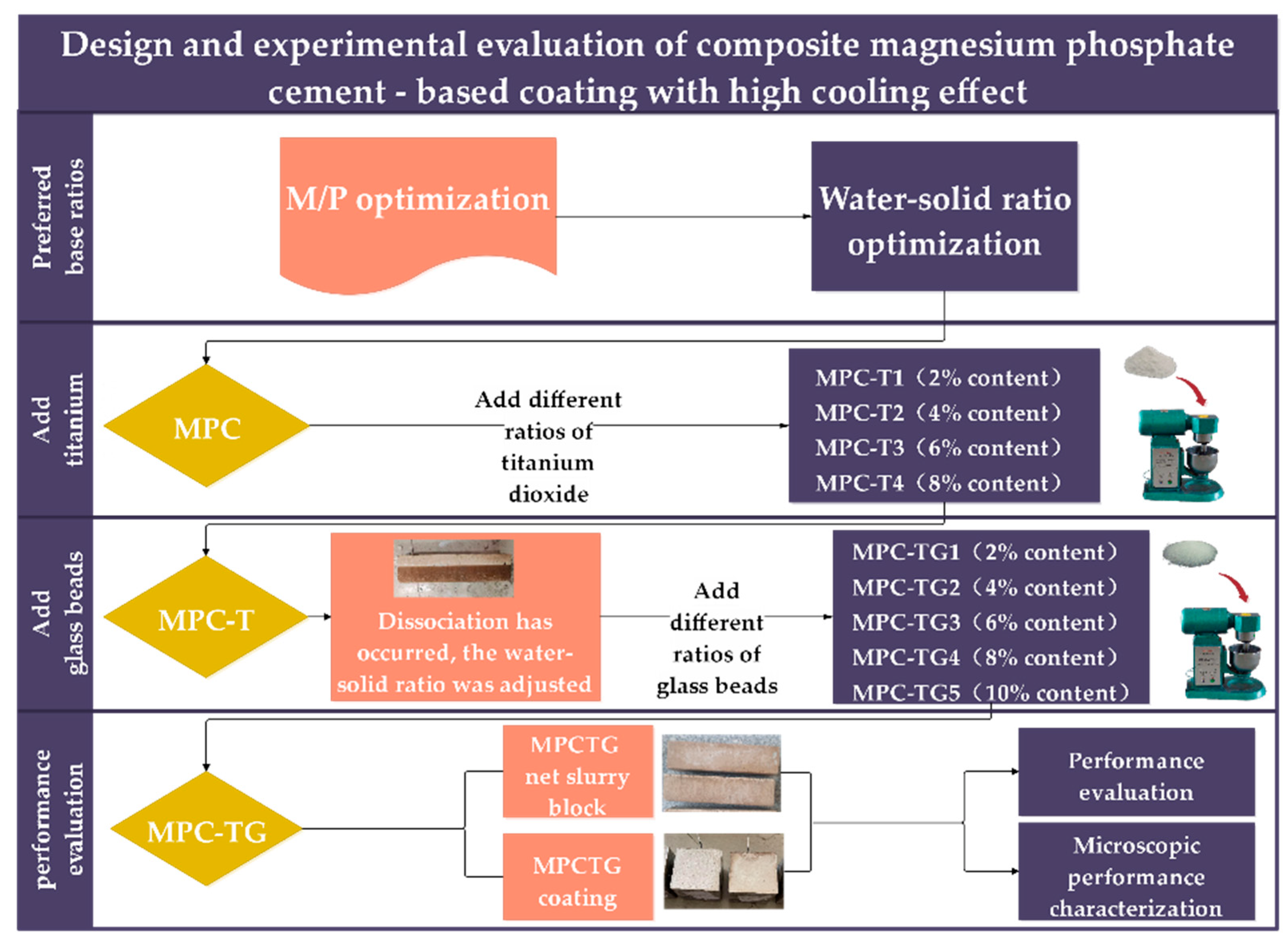

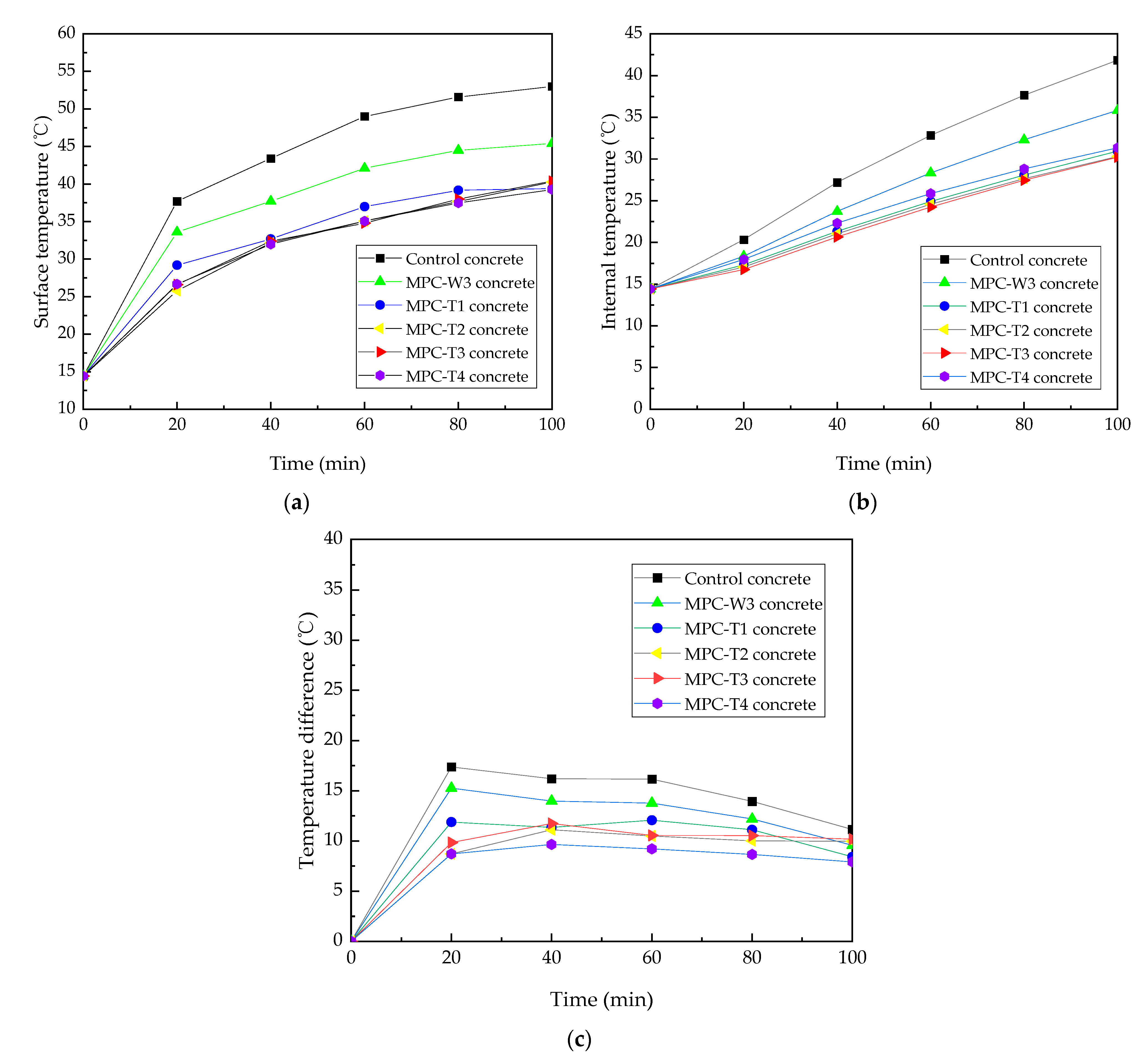
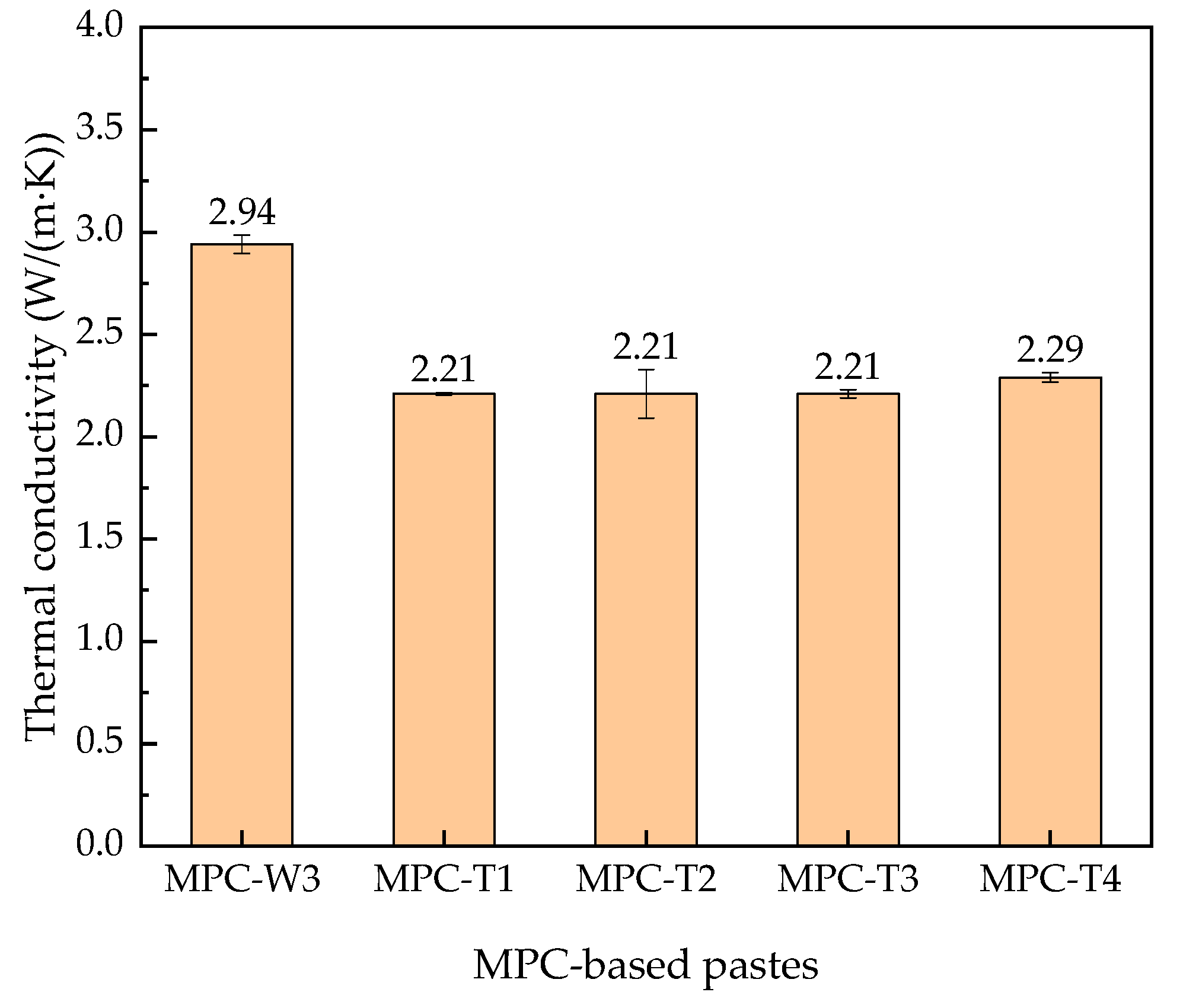
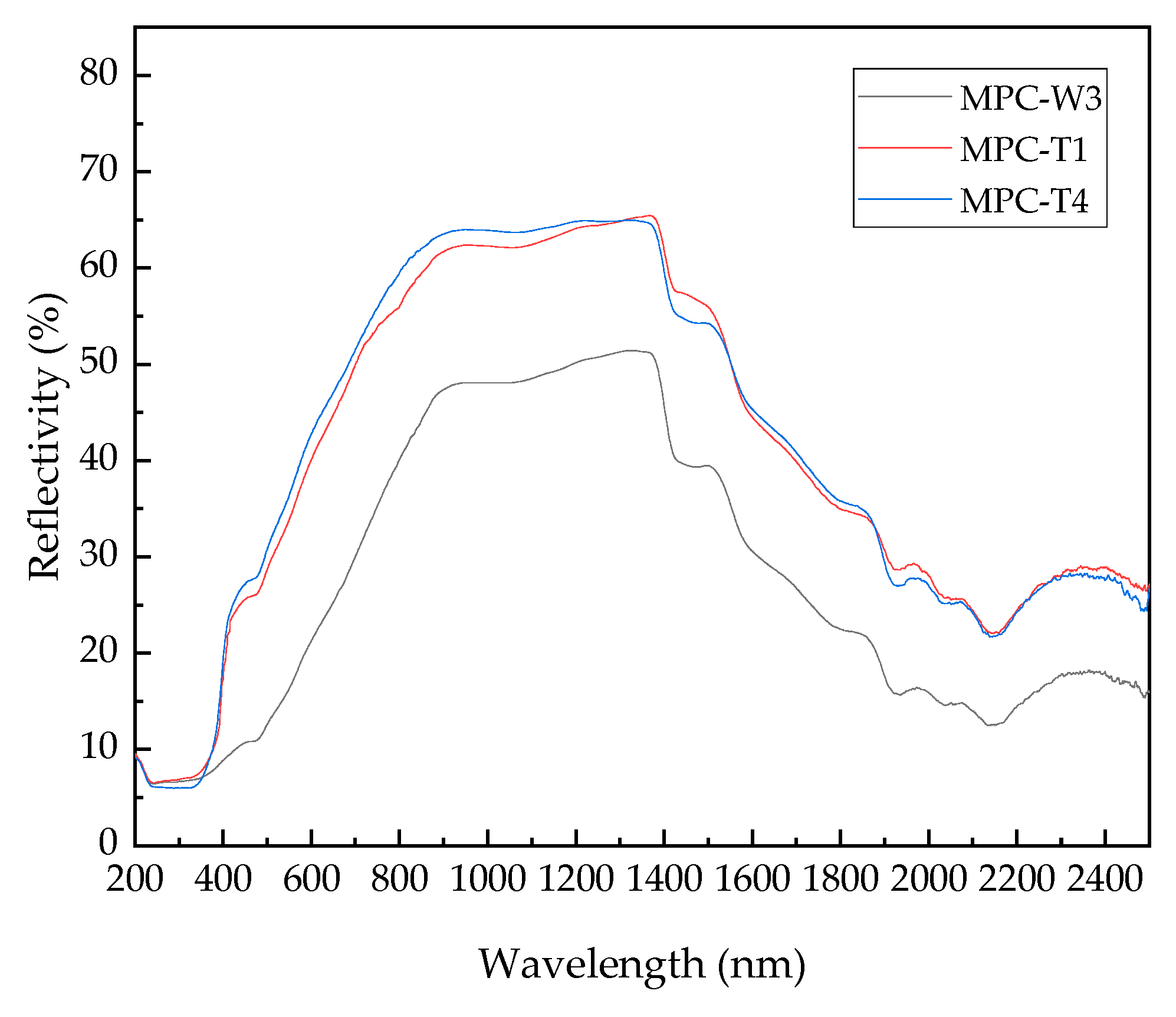
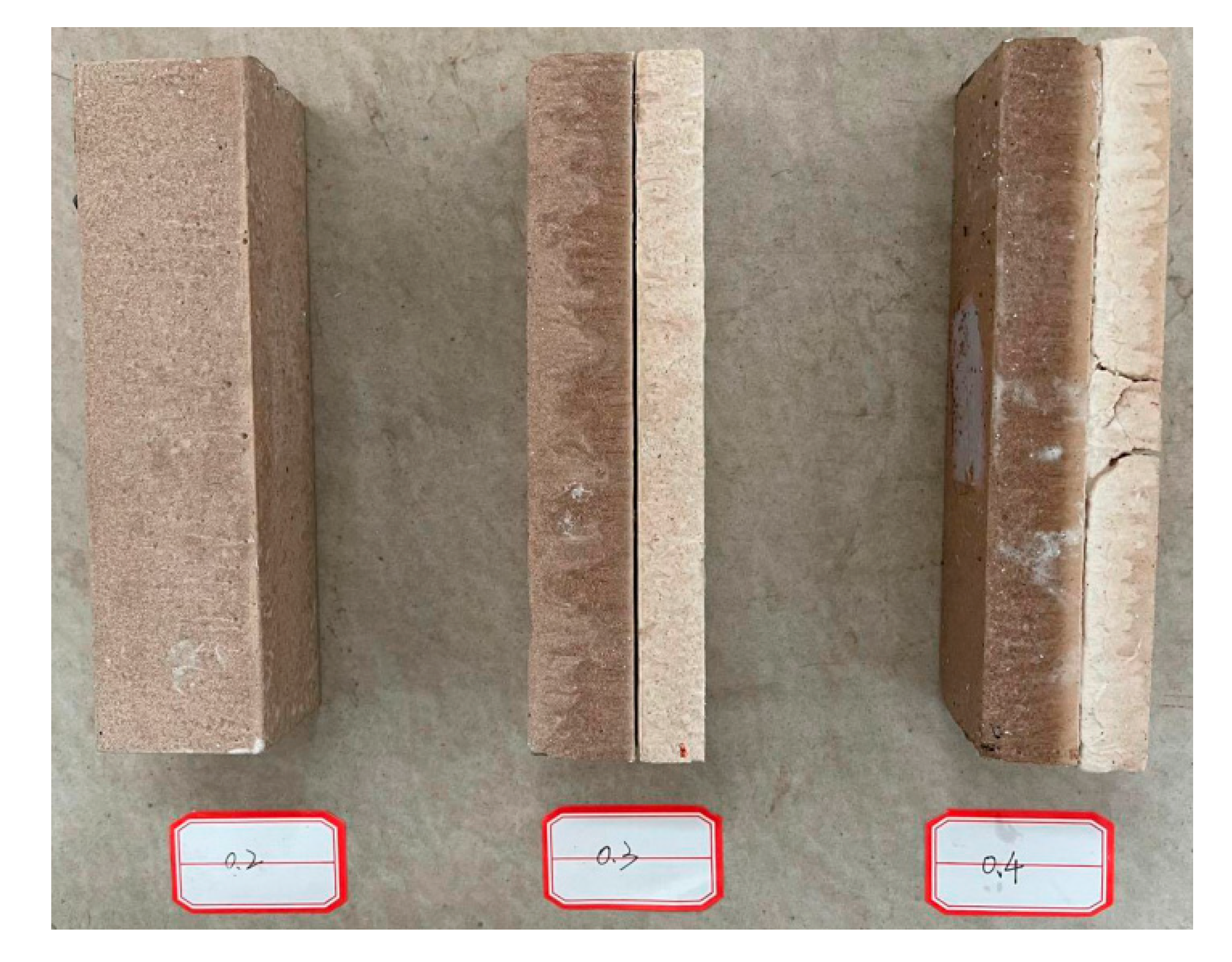
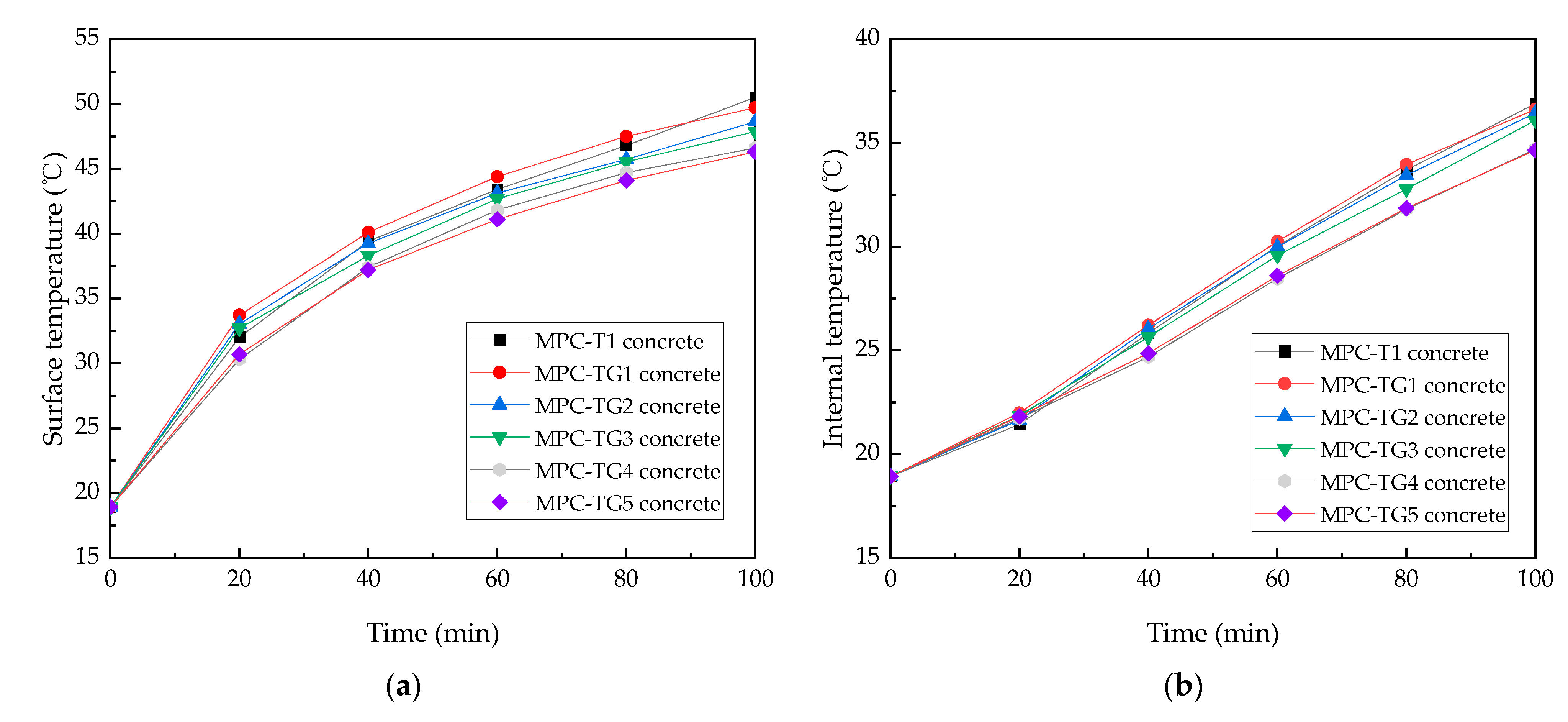
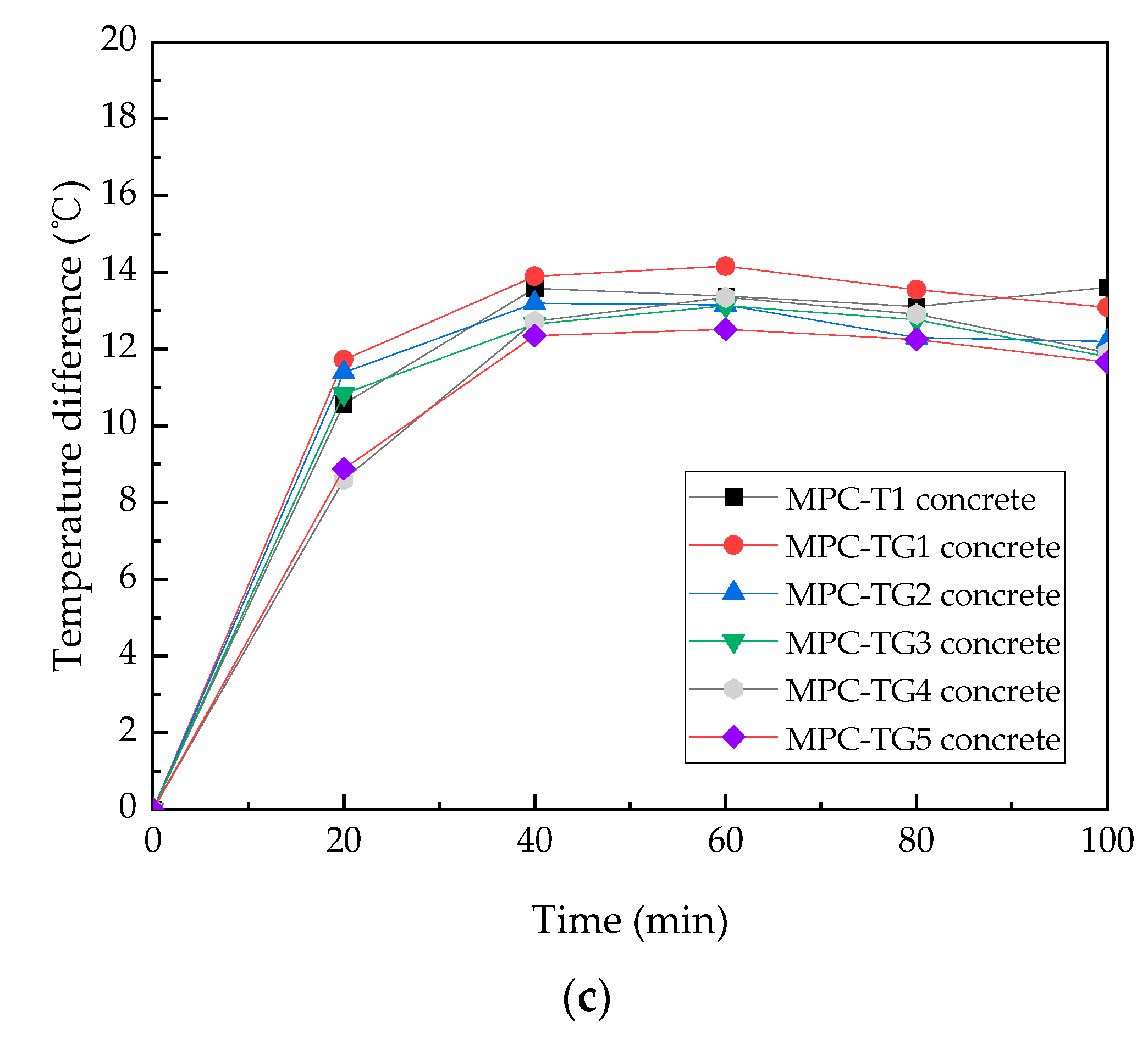
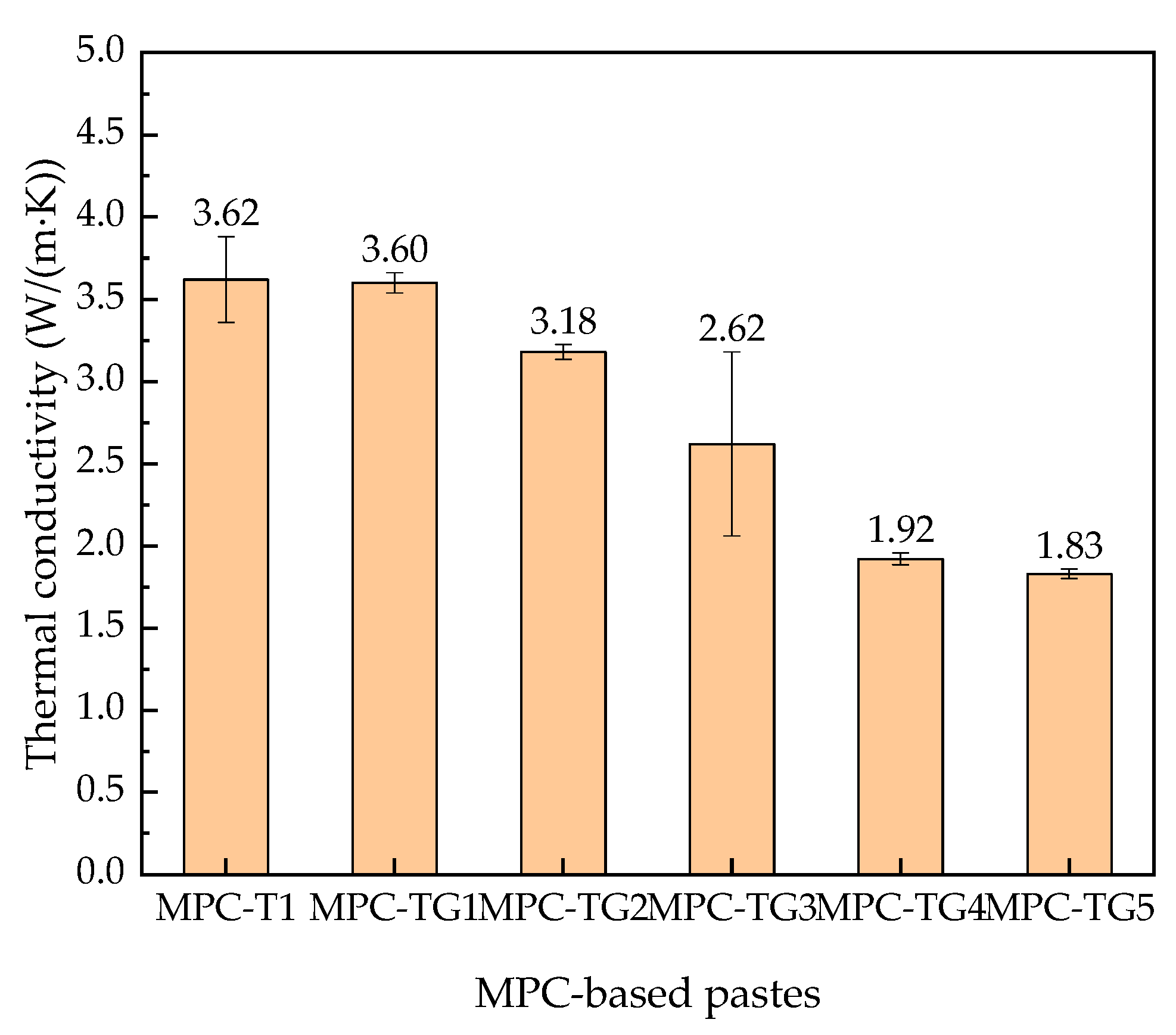

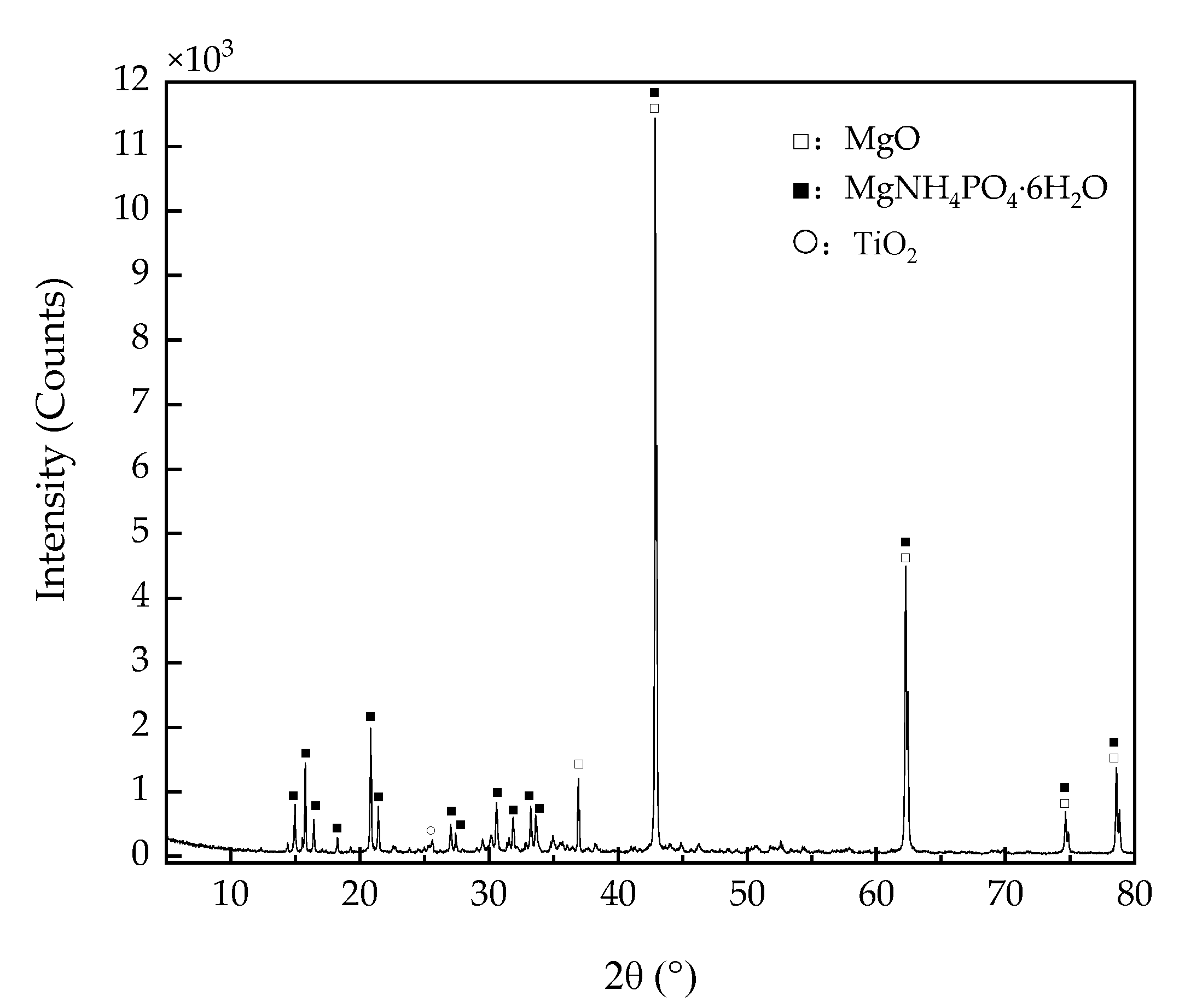

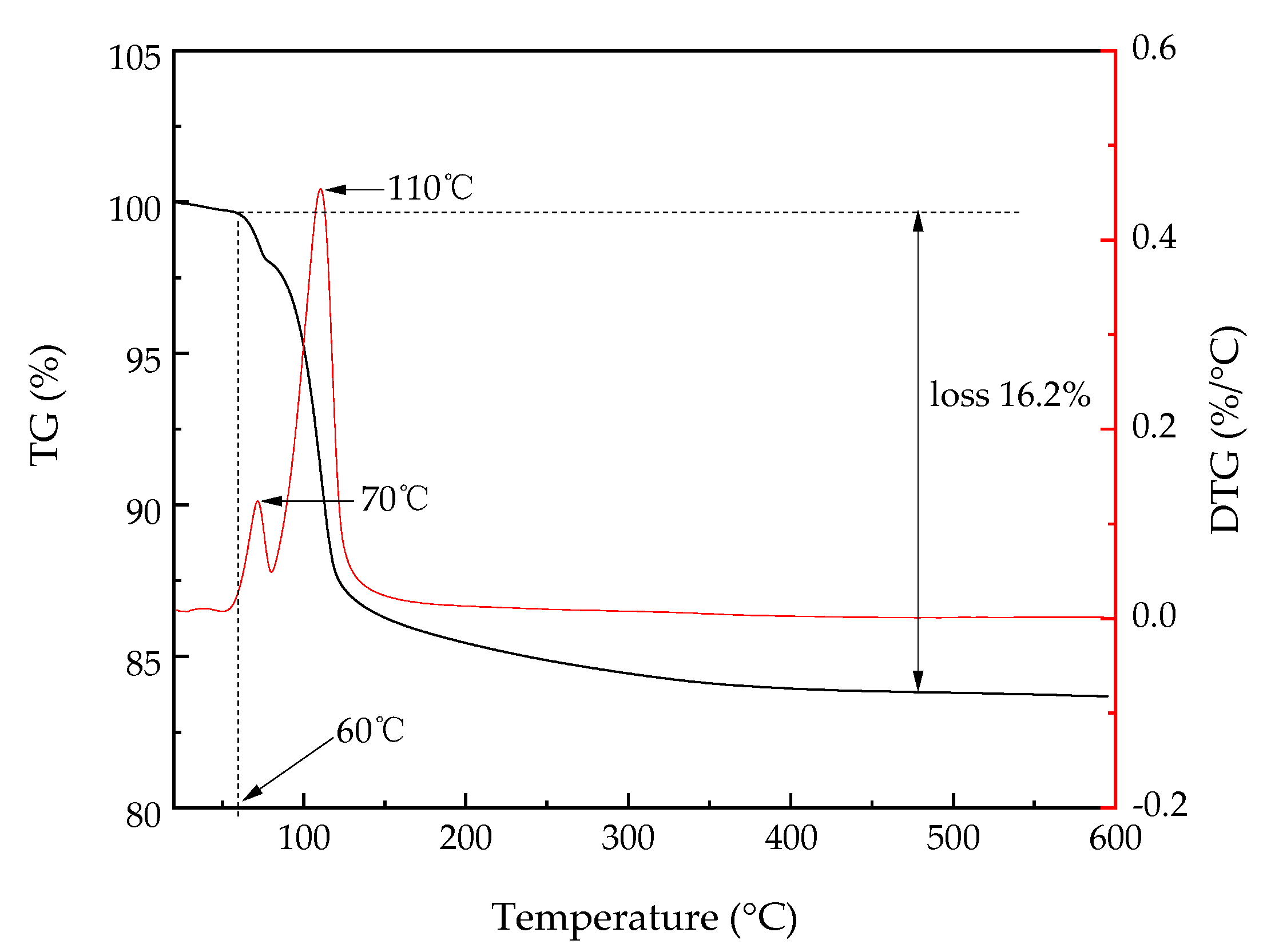
| Composition | MgO | SiO2 | CaO | Fe2O3 | MnO |
|---|---|---|---|---|---|
| M | 95.1 | 3.22 | 1.32 | 0.27 | 0.09 |
| MPC Pastes | M/P | Initial Setting Time/min | 3D Compressive Strength/MPa | 3D Flexural Strength/MPa |
|---|---|---|---|---|
| MPC-1 | 3 | 25 | 27.88 | 10.30 |
| MPC-2 | 4 | 23 | 37.78 | 14.25 |
| MPC-3 | 5 | 19 | 55.95 | 15.65 |
| MPC-4 | 6 | 18 | 47.85 | 15.10 |
| MPC-5 | 7 | 17 | 47.13 | 16.10 |
| MPC-6 | 8 | 15 | 38.60 | 15.30 |
| MPC-7 | 9 | 14 | 33.80 | 14.10 |
| MPC Pastes | Water-Solid Ratio | 3D Compressive Strength/MPa | 3D Flexural Strength/MPa | 3D Adhesive Strength/MPa |
|---|---|---|---|---|
| MPC-3 | 0.15 | 56.4 | 9.4 | 4.98 |
| MPC-W1 | 0.2 | 26.55 | 5.5 | 3.19 |
| MPC-W2 | 0.3 | 17.65 | 3.5 | 2.79 |
| MPC-W3 | 0.4 | 8.05 | 2.1 | 2.24 |
| MPC-W4 | 0.5 | 5.25 | 1.4 | 0.66 |
| MPC-Based Pastes | Ultraviolet Reflectance | Visible Reflectance | Near-Infrared Reflectance | Average Reflectance |
|---|---|---|---|---|
| MPC-W3 | 7.58 | 19.73 | 41.80 | 29.06 |
| MPC-T1 | 9.69 | 37.19 | 56.12 | 44.40 |
| MPC-T4 | 9.72 | 39.28 | 57.50 | 46.08 |
| MPC-Based Pastes | Ultraviolet Reflectance | Visible Reflectance | Near-Infrared Reflectance | Average Reflectance |
|---|---|---|---|---|
| MPC-T1 | 9.41 | 30.37 | 53.04 | 39.56 |
| MPC-TG4 | 9.60 | 32.08 | 51.37 | 39.69 |
| MPC-Based Paste | M/P | Water-Solid Ratio | Borax/M | Titanium Dioxide/M | Glass Bead/M |
|---|---|---|---|---|---|
| MPC-TG4 | 5 | 0.2 | 0.1 | 0.02 | 0.08 |
| MPC Paste | 3D Compressive Strength | 3D Flexural Strength | Adhesive Strength | Initial Setting Time | Fluidity |
|---|---|---|---|---|---|
| MPC-TG4 | 17.5 MPa | 3.9 MPa | 2.1 MPa | 40 min | 21.7 mm |
Publisher’s Note: MDPI stays neutral with regard to jurisdictional claims in published maps and institutional affiliations. |
© 2022 by the authors. Licensee MDPI, Basel, Switzerland. This article is an open access article distributed under the terms and conditions of the Creative Commons Attribution (CC BY) license (https://creativecommons.org/licenses/by/4.0/).
Share and Cite
Quan, X.; Guo, W.; Duan, B.; Tian, J.; Wu, X. Design and Experimental Evaluation of Composite Magnesium Phosphate Cement-Based Coating with High Cooling Effect. Sustainability 2022, 14, 10790. https://doi.org/10.3390/su141710790
Quan X, Guo W, Duan B, Tian J, Wu X. Design and Experimental Evaluation of Composite Magnesium Phosphate Cement-Based Coating with High Cooling Effect. Sustainability. 2022; 14(17):10790. https://doi.org/10.3390/su141710790
Chicago/Turabian StyleQuan, Xiankai, Wenhua Guo, Binxin Duan, Jun Tian, and Xiaowei Wu. 2022. "Design and Experimental Evaluation of Composite Magnesium Phosphate Cement-Based Coating with High Cooling Effect" Sustainability 14, no. 17: 10790. https://doi.org/10.3390/su141710790
APA StyleQuan, X., Guo, W., Duan, B., Tian, J., & Wu, X. (2022). Design and Experimental Evaluation of Composite Magnesium Phosphate Cement-Based Coating with High Cooling Effect. Sustainability, 14(17), 10790. https://doi.org/10.3390/su141710790



_Xie.png)






